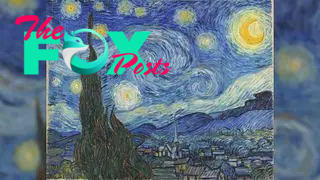Science
Van Gogh's 'Starry Night' contains surprisingly accurate physics — suggesting he understood the hidden 'dynamism of the sky'
New research suggests there is more to Vincent van Gogh's famous painting Starry Night than meets the eye. Its turbulent, swirling sky shares many characteristics with invisible fluid dynamics processes that occur in our real-world atmosphere, an analysis of the brushstrokes and colors in the painting reveals.
Van Gogh painted Starry Night in June 1889, while he was living in an asylum in southern France as he recovered from a mental breakdown that resulted in the self-mutilation of his left ear around six months earlier. The oil-on-canvas masterpiece shows the view of a swirling sky from the window of the painter's room with an imaginary village added in the foreground, and is famous for its detailed brushstrokes and use of bright hues.
The painting recently caught the eye of researchers in China who recognized some similarities between its spiraling shapes and the patterns seen in fluid dynamics — the study of the movements of fluids and gases. This inspired them to study the painting in greater detail.
In the new study, published Tuesday (Sept. 17) in the journal Physics of Fluids, the researchers analyzed the minute details of the brushstrokes and colors used in the paintings and found that these components both shared strong similarities with the "hidden turbulence" of gases in the atmosphere.
"It reveals a deep and intuitive understanding of natural phenomena," study co-author Yongxiang Huang, a fluid dynamics expert and oceanographer at Xiamen University in China, said in a statement. "Van Gogh’s precise representation of turbulence might be from studying the movement of clouds and the atmosphere or an innate sense of how to capture the dynamism of the sky."
Related: Hidden Van Gogh self-portrait discovered under 'peasant woman' painting

The researchers closely analyzed the 14 "whirls" in the painting's sky. Overall, these shapes generally followed patterns predicted by Kolmogorov’s law — a physical rule that describes how atmospheric gas moves at different scales depending on inertial energy. In the painting, that inertial energy is represented by the intensity of the yellows in the painting, the researchers wrote.
-

 Science2d ago
Science2d agoInside Capitol Hill’s Latest UFO Hearings
-

 Science2d ago
Science2d agoYou Won’t Want to Miss the Leonid Meteor Shower. Here’s How and When You Can See It
-

 Science2d ago
Science2d agoHere’s What Trump’s Win Means for NASA
-

 Science6d ago
Science6d agoWhy Risky Wildfire Zones Have Been Increasing Around the World
-

 Science6d ago
Science6d agoIt’s Time to Redefine What a Megafire Is in the Climate Change Era
-

 Science1w ago
Science1w ago4 Astronauts Return to Earth After Being Delayed by Boeing’s Capsule Trouble and Hurricane Milton
-

 Science1w ago
Science1w agoThe Elegance and Awkwardness of NASA’s New Moon Suit, Designed by Axiom and Prada
-

 Science1w ago
Science1w agoSpaceX Launches Its Mega Starship Rocket. This Time, Mechanical Arms Catch It at Landing


























